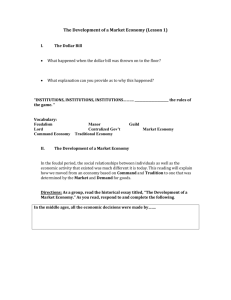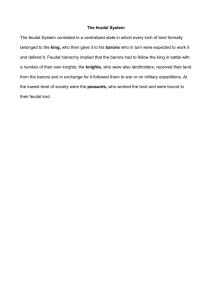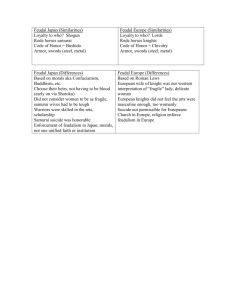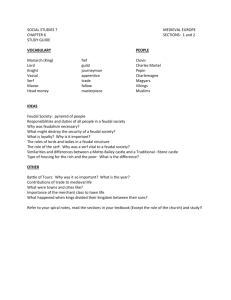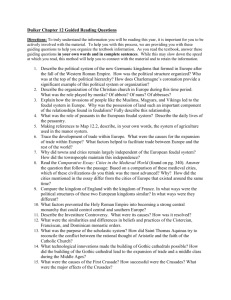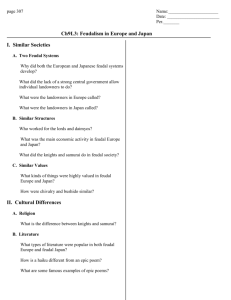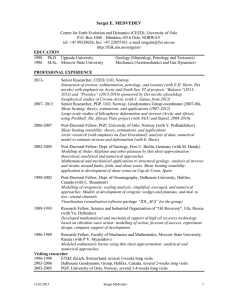downLoad
advertisement
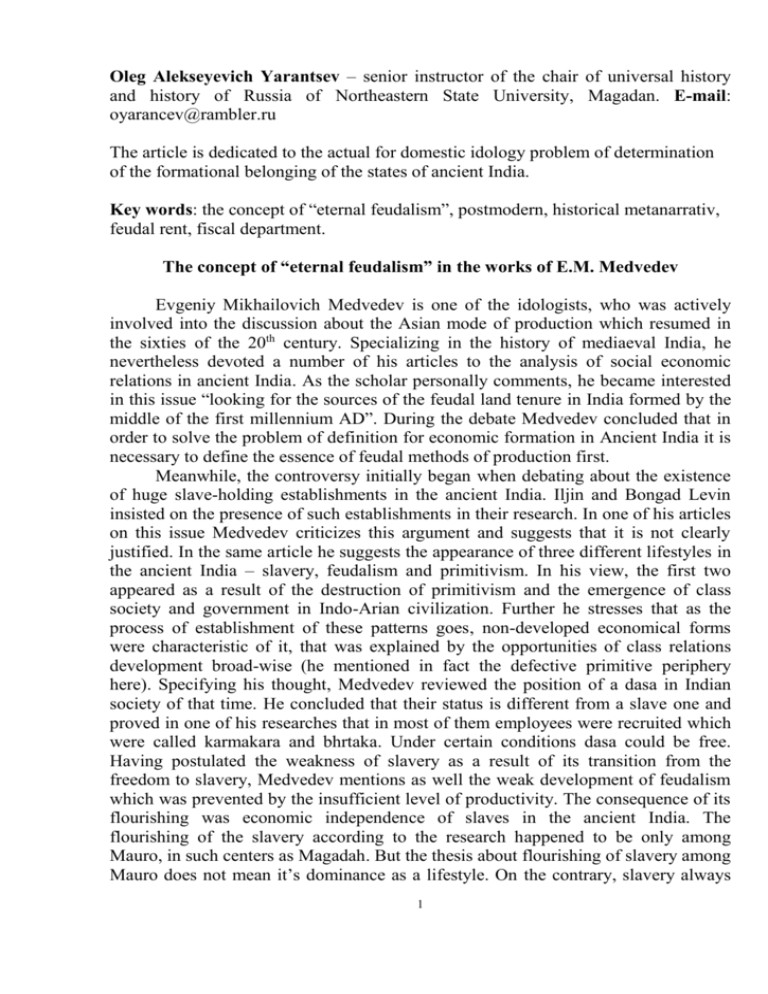
Oleg Alekseyevich Yarantsev – senior instructor of the chair of universal history and history of Russia of Northeastern State University, Magadan. E-mail: oyarancev@rambler.ru The article is dedicated to the actual for domestic idology problem of determination of the formational belonging of the states of ancient India. Key words: the concept of “eternal feudalism”, postmodern, historical metanarrativ, feudal rent, fiscal department. The concept of “eternal feudalism” in the works of E.M. Medvedev Evgeniy Mikhailovich Medvedev is one of the idologists, who was actively involved into the discussion about the Asian mode of production which resumed in the sixties of the 20th century. Specializing in the history of mediaeval India, he nevertheless devoted a number of his articles to the analysis of social economic relations in ancient India. As the scholar personally comments, he became interested in this issue “looking for the sources of the feudal land tenure in India formed by the middle of the first millennium AD”. During the debate Medvedev concluded that in order to solve the problem of definition for economic formation in Ancient India it is necessary to define the essence of feudal methods of production first. Meanwhile, the controversy initially began when debating about the existence of huge slave-holding establishments in the ancient India. Iljin and Bongad Levin insisted on the presence of such establishments in their research. In one of his articles on this issue Medvedev criticizes this argument and suggests that it is not clearly justified. In the same article he suggests the appearance of three different lifestyles in the ancient India – slavery, feudalism and primitivism. In his view, the first two appeared as a result of the destruction of primitivism and the emergence of class society and government in Indo-Arian civilization. Further he stresses that as the process of establishment of these patterns goes, non-developed economical forms were characteristic of it, that was explained by the opportunities of class relations development broad-wise (he mentioned in fact the defective primitive periphery here). Specifying his thought, Medvedev reviewed the position of a dasa in Indian society of that time. He concluded that their status is different from a slave one and proved in one of his researches that in most of them employees were recruited which were called karmakara and bhrtaka. Under certain conditions dasa could be free. Having postulated the weakness of slavery as a result of its transition from the freedom to slavery, Medvedev mentions as well the weak development of feudalism which was prevented by the insufficient level of productivity. The consequence of its flourishing was economic independence of slaves in the ancient India. The flourishing of the slavery according to the research happened to be only among Mauro, in such centers as Magadah. But the thesis about flourishing of slavery among Mauro does not mean it’s dominance as a lifestyle. On the contrary, slavery always 1 took only a small niche, which was determined by the creation of large farms. But even the latter he refuses to call slavery speaking about the fact that most of the employees of such farms were bonded serfs peasants. Analyzing the position of dasa and shudra Medvedev concludes that those were small farmers, bearing any guilt, but not slaves in fact. For example in Ghana and Sangha of the Northern-Western India there were only two estates – kshtarii and their dependant peasants – dasa. Dasa as well as shudra are connected with the term dasya which means “humiliating ministry”. Further on the discussion becomes more theoretical and Medvedev develops his ideas in to the original conception, which was called “eternal feudalism” in historiography. The theoretical justification of this theory began with an analysis of the role of the state land tax. E. M Medvedev claimed that in ancient India rent and taxes coincide, which is an indicator of the state feudal land ownership on the land. Cess - bali, kara, bhaga and others - conformed with the normal size of India's ancient feudal rents. Therefore, it may be considered as the so-called feudal rent-tax. Feudal owner is the one who sells the property, charging rent. The rate of 1 / 6 of sad-bhagar – “shad-bhaga” was traditional for India. This rate did not change until the XII century, which means that it covered the entire surplus product, which characterizes it as a feudal rent. In addition to public and private feudalism there was feudal land tenure. Many government positions in the fiscal and administrative apparatus were a benefice. Payments for officials were not fixed, but proportional to income in areas controlled by them. Arthashastra and Mahabharata give an idea of the office holding feudal type. Officer, having received a village as a benefice, acquired the right to tax it. In ancient India there were unqualified and office hereditary fief, similar to allodium and len. “Feudal land tenure in ancient India may be based on various conditions of hold. In some cases, this was a temporary office tenure, in other cases – freehold and inheritance tenure”. The main role, according to E. M Medvedev, has played a state ownership on land. Private feudal land tenure is widely spread, but only starting from Gupta. He defines the essence of economy in ancient India, as profeodalizm. In this regard, E.M Medvedev opposed interpretation of the exploitation as related to private property only. At the same time he criticized the theory of “the Asian mode of production” for the proposal for the rent-tax as seen as an explicit function of a specific characteristic of «the Asian mode of production», in which there is no private ownership of land, and despotic power of the king is the basis of management of public works on irrigation. E.M Medvedev himself mentioned the essence of the feudal state tax on land. The picture of socio-economic relations in ancient India, he presents as the following: 1) poor slavery (many transitional forms), patriarchal slavery. 2) The feudal way of life - with a predominance of the state exploitation by rent-tax, 1 / 6. 3) Private feudal tenure of basic types - temporary office incumbency, and hereditary conditions. He as well relates the emergence of feudal exploitation as the state exploitation to tribal relations, where there was guilt disguised as salary (bhrti) of the king for protection from enemies. 2 In view of the above said E.M Medvedev denied the right of the theory of “the Asian mode of production” to autonomy, as well as “the simple addition of two means of production can not be considered as the third special mode of production”. Since the debate increasingly related to the basic concepts of political economy, E.M Medvedev justified his vision of the term “methods of production” and the criteria of their systematization. In his view, G.F Il'in, making the progressiveness of slave culture and its impact on the political structure as a criterion, violates the principle of unity of the criterion. This criterion should be based on the quantitative predominance of the industrial relations in a particular society. Further, he draws attention to the fact that there is no unity in the interpretation of the minimum attributes of the mode of production. In the end, he finds that, in determining the mode of production of precapitalist formations only the relations of production, including the organization of production of material goods and means of distribution of the product should be taken into account. Productive forces - can not serve as a clear criterion, “because it is impossible to establish the specificity based on the manual labor of slavery and feudalism”. After analyzing the ancient society on the basis of this criterion, he demonstrated that in India, the independent union of farm employees possessing tools of production was typical of feudalism. There also presented the removal of surplus product of small farmers, while preserving their essential product for the management of reproduction, which is also typical of feudalism. As a result, it is the last element of industrial relations - the relationship for the distribution that corresponds to the principle of the unity criterion, as well as it meets the requirement of uniform classification criteria. The analysis of Indian communities is of great importance in the researches of E.M Medvedev on the definition of the mode of formation in ancient India. The community was the main feature of the theory “the Asian mode of production”. E.M Medvedev argued that there is no difference of who exists under feudal exploitation: an individual or a group. What is more important here is distribution of the surplus product while the relations within the community in this sense do not determine the mode of production. Supporters of the theory called the state rent-tax another sign of this tendency, but E.M Medvedev recalled that the rent of Marx is a general form of surplus labor, which is done for free and when the State is the feudal the rent coincides with the tax. In addition, a private annuity came from public service obligations by transferring them to individuals. The use of the term “feudal exploitation” does not mean private-feudal legal registration of property as necessary condition of it. As we saw above while discussing the formation in India, the issue of feudal property acquired importance. As a part of his original theory E.M Medvedev presents his own definition of feudal property, based not on legal grounds, but on the economic characteristics of the feudal mode of production. First, he criticized the review of a feudal property only from the viewpoint of feudal right to dispose of their land because if viewed in such a way feudal ownership becomes as well a legal feudal right on that land. According to G.F Il'in exploitation and rents arise only with 3 the emergence of property rights in the above mentioned sense. E.M Medvedev claimed that the tax exploitation is feudal by its economic nature and is not affiliated with a private feudal property. Feudal property as an economic category can not be divorced from the relations of production and distribution. In this regard, he mentions Marx definition of property, - “a historically specific form of relations between people in the process of production, about the appropriation of the means of production and life facilities”. According to E.M Medvedev, medievalist-Westerners, interpreting the property only as a legal category, are away from the conclusion that the distribution of incumbency means transforming the public service obligations to the private annuity. At the same time the state exploitation by means of land tax with the distribution of income shares in conditional grant was the normal form of feudalism. As a result of the development of feudalism in India, there happened the sharing of the surplus product between a dominant class of feudal lords and the subordinate class of petty feudal lords, managing the land, but receiving an annuity only as a difference between the amount of surplus product and rent-tax for the benefit of the dominant class. In this respect, E.M Medvedev agrees with L.B Alaev, who introduced the concept of two forms of feudal property – “supreme” and “slave”. “Slave” property here is understood as a “private property of landlord - payer cess”. The right to such property does not distinguish between labor and exploitative property. In this case exploiters, paying the rent-tax amount to the State, make the aggregate exploiter together with the State. Therefore, the most important thing here is the relationship between tenant and landlord, and not the relations of redistribution of surplus product between supreme and subordinate owners. In the case of “slave” property economic coercion becomes more important, therefore, regulated by more stringent law. “Supreme” property relies mostly on non-economic coercion. Summarizing the analysis of characteristics of property status in ancient India, E.M Medvedev writes: “Supreme” property freely moves from state to individual and vice versa. Accordingly, there is no sufficient evident to oppose state tax on land rent and taxes in general to private rent. Feudalist collected the same aggregate rent-tax, as fiscal authority did”. In summary we can say that the feudal ownership tends to the development of forms with primarily non-economic forms of coercion, in which economic coercion is becoming more prominent concern. The latter form is realized through the growth of private (in the legal sense) feudal land tenure, represented in India by «slave» property. Thus, Medvedev considered an ancient Indian society to be ranneklassoviy, multicultural, including the feudal, slavery, and primitive way of lifestyle. It is the transition from primitivism to feudalism, where the time of genesis happens simultaneously with the formation of state-feudal exploitation (first half of the first thousand BC). 4 Literature and the sources: 1. E. M. Medvedev. To a question about the forms of landownership in North India in VI – VII centuries / E.M. Medvedev // the problems of oriental study. – 1959. – № 1; Monuments of medieval Indian literature as source on the history of social and economic relations in feudal India / E.M. Medvedev // the historiography of the countries of the East, 1969; The cities of North India in VI – VII centuries /E.M. Medvedev // the countries and peoples of the east. – Iss. XIV. – M., 1972. 2. E. M. Medvedev. To a question about the social and economic system of ancient India / E.M. Medvedev // the peoples of Asia and Africa. – 1966. – № 6; Feudal relations in ancient and medieval India / E.M. Medvedev // the peoples of Asia and Africa. – 1970. – № 3 ; Rent, tax, property. Some problems of Indian feudalism/E.M. Medvedev // the problems of the history of India and countries of the Middle East. – M. : Science, 1972. – 300 p. ; Genesis of feudal formation in India: the descriptions of economic and social history of India. – M. : Science, 1973. – 200 p. ; Basic stages of the development of feudal relations in India in the antiquity and the middle ages / E.M. Medvedev // main problems of the history of India. – M. : Science, 1981. – 272 p. ; Forming of exploiter classes in India in the antiquity and into the early middle ages / E.M. Medvedev // classes and class in the pre-capitalist societies of Asia: the problem of social mobility. – M. : Science, 1986. – 248 p. 3. E. M. Medvedev. Studying by the Soviet historians the problem of the forming traditional society in India / E.M. Medvedev // the contemporary historiography of the countries of the foreign east. M.: Science, 1975. – P. 24. 4. G.M. Bongard- Levin, G.F. Il’in. Ancient India. Historical description. – M., 1969. 5. Shripad Amrit Dange. India from the primitive communism to the decomposition of slaveholding system. – M. : Science, 1975. – 200 p. 6. E.M. Medvedev. To a question about the social and economic system of ancient India / E.M. Medvedev // the peoples of Asia and Africa. – 1966. – № 6. 7. A.L. Basham The wonder that was India.. L., 1967, p. 154. T. W. Rhys Davids. Buddhist India. L., 1903. – 55 p. 8. E.M. Medvedev. Karmakara bhrtaka. To the problem of the origin of the lowest castes / E.M. Medvedev // castes in India. – M., 1965. 9. E.M. Medvedev. To a question about the social and economic system of ancient India / E.M. Medvedev // the peoples of Asia and Africa. – 1966. – № 6. – P. 66, 69, 74. 10. E.M. Medvedev. Feudal relations in ancient and medieval India / E.M. Medvedev // the peoples of Asia and Africa. – 1970. – № 3. – P. 73 – 75. 11. EM. Medvedev. Experience in study of ancient Indian community according to the data of toponymy / E.M. Medvedev // India in the antiquity. (Coll. of articles). – M., 1964. 12. E.M. Medvedev. Feudal relations in ancient and medieval India/E.M. Medvedev // the peoples of Asia and Africa. – 1970. – № 3. – P. 77. 5 13. E.M. Medvedev. Rent, tax, property. Some problems of Indian feudalism / E.M. Medvedev // the problems of the history of India and countries of the Middle East. – M. : Science, 1972. – P. 39, 35. 14. History of India into the Middle Ages. – M., 1968. – P. 113 – 118. 15. E.M. Medvedev. Basic stages of the development of feudal relations in India in the antiquity and the middle ages / E.M. Medvedev // the main problems of the history of India. – M., 1981. – P. 110, 113. 16. E.M. Medvedev. Genezis of feudal formation in India/E.M. Medvedev/the descriptions of economic and social history of India. – M. : Science, 1973. – P. 94. 6

